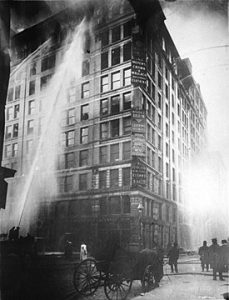Do you remember when our communities were home to numerous garment factories providing jobs for thousands of employees? The dedicated workers manufactured high quality shirts, dresses, blouses and slacks. They worked long hours for meager wages.
I had a flashback to the old industry when my wife and I met a friendly couple at one of Lancaster’s tourist havens. They were reared in New York City, the lady in Manhattan, where there was a prosperous garment district. I wonder if it’s still prosperous today?

She relayed a story few of my younger readers have ever read about, an event that touched the heart and soul of America, a tragic page in labor history I covered in my class during my teaching days. The late aunt of this lady survived the Triangle Waist Co. fire on March 25, 1911 in New York City.
The Triangle Shirt Waist Company was located at the intersection of Green Street and Washington Place. They manufactured women’s blouses, which at the time were called shirtwaists.
The factory was on the top three floors of a ten-story building. Most employees were young immigrant women from Germany, Italy and Eastern Europe, some were only 13 years of age. They worked 60 to 72-hour weeks, some worked 14-hour shifts; and you think we have it tough!
Safety conditions barely existed, the floors of the factory had scraps of fabric, patterns, flammable textiles and tissue paper. Some of the men who cut the fabric smoked on the job. There were a few buckets of water in the room to extinguish any fire.
The fire began on the eighth floor, sparked by a match, cigarette or faulty electrical wiring. Workers from the tenth and eighth floors were warned and quickly evacuated but no one alerted the ninth floor. The single fire escape soon collapsed and the elevator stopped working. The ninth floor had only two doors to the stairway, one was locked and the other, stairs were filled with flames and black smoke. Panic and desperation gripped the workers who struggled to escape.
Sixty-two desperate women attempted to avoid the flames by breaking the windows and jumped out of the ninth-story window. The firemen attempted to use nets to save the women but the nets failed. Others jumped down the elevator shaft. The firemen were unable to extinguish the flames and there were no ladders that could reach above the sixth floor.
The death toll was 148; 141 died at the scene and seven survivors died in hospitals. The owners of the company fled to the roof and survived. As a result of the tragedy the owners were put on trial, but as in the present day, clever defense attorneys confused the witnesses and stated the prosecution was unable to prove the owners locked the exit doors, thus they were acquitted of any wrong doing.
In 1913 a civil suit was also unsuccessful. In the end, $75 was paid per each deceased victim; yes you read that correctly, $75. The owners were paid $60,000 from an insurance company.
Two years later Max Blanck, one of the owners, was arrested for locking the factory door during working hours and was fined $20.
The building was refurbished after the fire. Today is it owned by New York University and is known as the Brown Building of Science. The building was placed on the National Historical Register in 1991. Two plaques in front of the building commemorate the women who lost their lives in the fire. At a mass meeting in New York in 1911, Rose Schneiderman said, “This is not the first time girls have been burned alive in the city. Every week I must learn of the untimely death of one of my sister workers. Every year thousands of us are maimed. The life of men and women is so cheap and property is so sacred. There are so many of us for one job it matters little is 148 of us are burned to death.” Thus ended a tragic chapter for the American worker.









